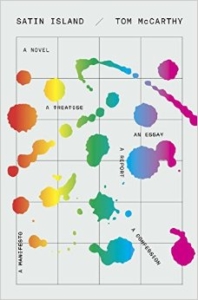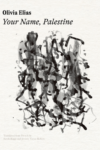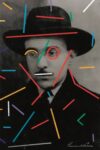 [Knopf; 2015]
[Knopf; 2015]
Tom McCarthy’s fiction quite palpably poses a challenge to entrenched reading habits and subverts conventional literary practice, but its rebellious spirit is usually categorized as modernist rather than postmodernist. Even though most of the qualities found in McCarthy’s work that suggest the influence of modernism equally suggest the influence of postmodernism, and even though specifically the mark of such postmodern writers as Don DeLillo and Thomas Pynchon is readily apparent, discussion of his work has largely focused on McCarthy as a kind of neomodernist.
The most obvious explanation for the way McCarthy’s books have been received, at least in Great Britain, is that British fiction largely skipped over the phase in 20th century fiction generally labeled “postmodern,” instead renewing after World War II the British tradition of social and psychological realism (the latter supplementing the former as the only really lasting legacy of modernism). With a few notable exceptions — B.S. Johnson, arguably the early Ian McEwan, most recently Gabriel Josipovici — postwar British fiction has offered little in the way of “experimental” or “innovative” fiction of the sort associated with postmodernism in the United States (or, in a different way, continental Europe). This fact is what made Zadie Smith’s well-known essay, “Two Paths for the Novel,” seem rather curious. In it she praises Tom McCarthy for showing an alternative way forward for contemporary fiction, but her account holds McCarthy up as a singular figure, an experimental writer, almost as if a previous generation of undeniably experimental writers in the U.S. and Europe had not illuminated this path already, going back almost 50 years.
A more charitable reading of Smith’s essay would have it addressing primarily a British audience and proposing to writers and critics that British fiction should move closer to American and continental fiction in becoming more adventurous. Tom McCarthy’s fiction contests reigning assumptions both about the adequacy of realism and about the conventions of storytelling, but the real issue is whether it validates the premise sustaining experimental fiction (modernist or postmodernist) — that the art of fiction must remain open to change and replenishment — and extends the possibilities of literary innovation as least as persuasively as the previous efforts to affirm the spirit of modernism prior to McCarthy’s. I think it does, but it is more appropriate to think of McCarthy as continuing on a path made visible by his postmodern predecessors than blazing a new one on ground never before uncovered. McCarthy’s fiction has much to offer readers receptive to unorthodox methods and a different kind of reading experience, although its achievement is only enhanced and clarified if considered not in isolation, as a reemergence of modernism, but as a distinctive contribution to what can now only be called a tradition of adventurous practices by writers trying continually to renew the vitality of fiction as a literary form.
Remainder, the book that first brought attention to McCarthy as a novelist, certainly seemed more European than British, although the influence of DeLillo also seems especially strong in the extremity of the novel’s subject and the deadpan detachment of its style. Like most of DeLillo’s fiction, Remainder does not so far depart from recognizable reality as to completely strain credulity, edging into the surrealistic or fantastic, but the narrative pushes on the plausibly real hard enough that it takes on the atmosphere of the uncanny. Remainder’s protagonist is in such an extreme state of consciousness that he must reiterate “ordinary” experience obsessively in order to be convinced of its authenticity. He arranges for “reenactments” of that experience, so precisely and insistently detailed that they might embody the real exactly enough (more exactly than reality itself) to satisfy his brain-altered need for order (a malady brought on when, before the present narrative begins, he is struck in the head by an object “falling from the sky”). Although the plot of Remainder could be described as simply the working-out of the narrator-protagonist’s repetition-compulsion, the urgency and determination with which he carries out this compulsion nevertheless makes for fascinating reading.
The protagonist of McCarthy’s new novel, Satin Island, does not initially show signs of sharing such a compulsion, although as a “corporate anthropologist” he is someone who is trained to observe closely and discern patterns and hidden meaning. Calling himself “U,” he seems to be functioning well enough in his role as member of a team working on “the Project,” identified by name as “Koob-Sassen,” the ultimate details of which remain murky, even if its ambitions are clearly far-reaching and possibly sinister. Yet we also can’t help but note U’s descriptive rigor when recording his observations of the environments he traverses. Upon entering his employer’s offices he finds
Separated from each other by floor-to-ceiling glass partitions on which lower-case letters in the Company’s own distinctive font were stenciled, these compartments ran on one into the next, creating an expansive vista in which, sketches, diagrams, and other such configurations of precious data, lying face-up on curved tabletops, pinned to walls or drawn on whiteboards, or, occasionally (and this made the data seem all the more valuable, fragile even), on the glass itself, seemed to dialogue with one another in a rich and esoteric language, the scene conveying (deliberately, of course) the impression that this was not only a place of business, but, beyond that, a hermetic zone, a zone of alchemy, a crucible in which whole worlds were in the mix. . . .
This perception of reality in its “configurations,” interpreting these configurations as if they expressed a “rich and esoteric language,” is a trait U holds in common with Remainder’s protagonist, although he continues to act more as a dispassionate observer than a fully engaged participant in the active creation of the patterns and relationships that form his experience of the world.
U as well works for a company that itself seeks to assert itself by exploiting patterns and relationships, hence its need for someone like U to study structures and systems, “identifying these, prising them out and holding them up, kicking and wriggling, to the light,” assisting the Company in its ability “to contextualize and nuance,” to advise its clients, both private and public, “how to elaborate and frame regenerative strategies.” Koob-Sassen “involved many hook-ups, interfaces, transpositions . . . It was a project formed of many other projects, linked to many other projects — which renders it well-nigh impossible to say where it began and ended, to discover its ‘content,’ bulk, or outline.” Nevertheless, “there’s probably not a single area of your daily life that it hasn’t, in some way or other, touched on, penetrated, changed; although you probably don’t know this.” Satin Island thus differs from Remainder in embedding the story of U’s preoccupation with patterns, grids, and networks in the context of global capitalism and the control of information.
While a critique of neoliberalism and the hegemony of transnational capitalism is certainly implicit in Satin Island, the novel mostly keeps the Company and its workings in the background, aside from the occasional appearances of the “boss,” Peyman, the Company’s “public face and poster boy,” whose aphorisms act as the clearest indication of what Koob-Sassen likely entails: “What are objects? Bundles of relations.” “The end point to which [design] strives is a state in which the world is one hundred percent synthetic, made by man for man, according to his desires.” The realities of the new capitalist world order are graphically illustrated in the story U’s current lover tells of the abuse she suffered while participating in a protest at a G-8 summit, although this episode ultimately seems rather heavy-handed, too transparently a departure from the portrayal of the Company as an ominously mysterious entity whose tentacles reach everywhere but whose body remains in the shadows. This portrayal might be derivative of Pynchon and DeLillo, but even granting that the woman’s account is chilling enough, that account sacrifices the subtlety and provocative indeterminacy employed by these writers, making too explicit what might stay implicit in U’s process of self-examination.
While ostensibly U is narrating his attempt to write the “Great Report,” a text that will explain everything about the present era, his story eventually becomes the narrative of U’s disillusionment, not just with the prospect of writing this book, not just the very idea that such a book is actually possible to write, but with his own role in the larger Project, which he comes to see as anti-human. This process comes to its culmination after U has a dream in which he is flying in a helicopter over a gigantic complex that turns out to be a massive trash dump, a “glowing ooze, which hinted at a deeper, almost infinite reserve of yet-more-glowing ooze inside the trash mountain’s main body.” This is Satin Island. Realizing that the name must surely be a dream-filtered reference to New York’s Staten Island, when he finds himself in New York City for a symposium, U ventures to the Staten Island Ferry terminal, where he envisions traveling over to Staten Island, imagining it as “some other place where everything, even our crimes, has been composted down, mulched over, transformed into moss, pasture, and wetland for the ducks and coots to build their nests in. Maybe I could somehow nest there too. . . .” He does not get on the ferry, suddenly realizing that to do so would be “profoundly meaningless,” although not going “was, of course, profoundly meaningless as well.”
Finally Satin Island could be called the story of its protagonist’s psychological shift, from an initial state of reluctance to examine his commitment to “meaning” as a coherent concept whose fulfillment is possible to a willing acknowledgement of the essential meaninglessness of human activity, no matter how many patterns, connections, and orderly arrangements we think we see. It might be called a story about the loss of innocence, and as such the novel is finally not very formally adventurous. But McCarthy’s innovations are not at the level of narrative structure (events in his novels happen sequentially, however bizarre they might appear to be at times), but instead in the way he represents interior states not through conventional strategies of psychological realism (free indirect discourse, stream-of-consciousness) but by in effect exteriorizing state of mind in his first-person narrators’ preoccupation with spatial constructs and sensory configurations, as if they are projecting onto the world their irresistible need for perceptible reality to cohere, for things to add up.
This preoccupation is registered directly in the narrators’ language, their minute observations and often intricate descriptions. McCarthy’s prose style may be his most original achievement, its expository and descriptive powers compelling attention while also challenging common notions of “poetic” prose:
Staten Island was no longer grey, and it had grown: the sun was right behind it now, haloing it, transmuting it into a brilliant orange pool that spread across the harbour like a second mass of water, ones set on a slightly different plane that spilled across the first one when the two planes intersected. This pool of light was spreading right towards the ferry, swallowing it up, dismantling it, pixel by orange pixel. Its haze spread even further, past the boat’s still-discernible stern, turning the ferry’s wake, and those of other vessels, a metallic, silvery shade. There were scores of wakes, crossing each other in irregular and tangled patterns.
The essentially geometric figurations in U’s evocation of New York Harbor as he prepares to leave the terminal — superimposed planes, intersecting patterns — captures U’s way of apprehending the world while also providing us with an alternative perspective on what could be just another lyrically rendered scene. At the same time, immediately following U’s notation of the “irregular and tangled patterns,” he adds further: “Networks of kinship: the phrase flashed across my mind; I snorted in derision.” That the patterns now appear irregular and tangled, that he now dismisses his previous belief in “networks,” suggests that U has had a revelation of sorts, even if it is the revelation that the overarching explanation he seeks will not be revealed. In this way, the protagonist of Satin Island, unlike the protagonist of Remainder, is allowed to abandon his illusions. Whether this represents an advance in McCarthy’s art or a retreat to a more familiar sort of narrative device perhaps remains to be seen.
Daniel Green is a literary critic whose essays and reviews have appeared in a variety of publications, both online and in print. His website can be found at: http://noggs.typepad.com.
This post may contain affiliate links.







